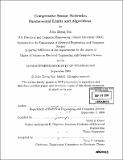| dc.contributor.advisor | Vivek K Goyal. | en_US |
| dc.contributor.author | Sun, John Zheng | en_US |
| dc.contributor.other | Massachusetts Institute of Technology. Dept. of Electrical Engineering and Computer Science. | en_US |
| dc.date.accessioned | 2010-04-28T17:15:18Z | |
| dc.date.available | 2010-04-28T17:15:18Z | |
| dc.date.copyright | 2009 | en_US |
| dc.date.issued | 2009 | en_US |
| dc.identifier.uri | http://hdl.handle.net/1721.1/54653 | |
| dc.description | Thesis (S.M.)--Massachusetts Institute of Technology, Dept. of Electrical Engineering and Computer Science, 2009. | en_US |
| dc.description | Cataloged from PDF version of thesis. | en_US |
| dc.description | Includes bibliographical references (p. 85-92). | en_US |
| dc.description.abstract | Compressed sensing is a non-adaptive compression method that takes advantage of natural sparsity at the input and is fast gaining relevance to both researchers and engineers for its universality and applicability. First developed by Candis et al., the subject has seen a surge of high-quality results both in its theory and applications. This thesis extends compressed sensing ideas to sensor networks and other bandwidth-constrained communication systems. In particular, we explore the limits of performance of compressive sensor networks in relation to fundamental operations such as quantization and parameter estimation. Since compressed sensing is originally formulated as a real-valued problem, quantization of the measurements is a very natural extension. Although several researchers have proposed modified reconstruction methods that mitigate quantization noise for a fixed quantizer, the optimal design of such quantizers is still unknown. We propose to find the optimal quantizer in terms of minimizing quantization error by using recent results in functional scalar quantization. The best quantizer in this case is not the optimal design for the measurements themselves but rather is reweighted by a factor we call the sensitivity. Numerical results demonstrate a constant-factor improvement in the fixed-rate case. Parameter estimation is an important goal of many sensing systems since users often care about some function of the data rather than the data itself. | en_US |
| dc.description.abstract | (cont.) Thus, it is of interest to see how efficiently nodes using compressed sensing can estimate a parameter, and if the measurements scalings can be less restrictive than the bounds in the literature. We explore this problem for time difference and angle of arrival, two common methods for source geolocation. We first derive Cramer-Rao lower bounds for both parameters and show that a practical block-OMP estimator can be relatively efficient for signal reconstruction. However, there is a large gap between theory and practice for time difference or angle of arrival estimation, which demonstrates the CRB to be an optimistic lower bound for nonlinear estimation. We also find scaling laws 'for time difference estimation in the discrete case. This is strongly related to partial support recovery, and we derive some new sufficient conditions that show a very simple reconstruction algorithm can achieve substantially better scaling than full support recovery suggests is possible. | en_US |
| dc.description.statementofresponsibility | by John Zheng Sun. | en_US |
| dc.format.extent | 92 p. | en_US |
| dc.language.iso | eng | en_US |
| dc.publisher | Massachusetts Institute of Technology | en_US |
| dc.rights | M.I.T. theses are protected by
copyright. They may be viewed from this source for any purpose, but
reproduction or distribution in any format is prohibited without written
permission. See provided URL for inquiries about permission. | en_US |
| dc.rights.uri | http://dspace.mit.edu/handle/1721.1/7582 | en_US |
| dc.subject | Electrical Engineering and Computer Science. | en_US |
| dc.title | Compressive sensor networks : fundamental limits and algorithms | en_US |
| dc.type | Thesis | en_US |
| dc.description.degree | S.M. | en_US |
| dc.contributor.department | Massachusetts Institute of Technology. Department of Electrical Engineering and Computer Science | |
| dc.identifier.oclc | 606600152 | en_US |
